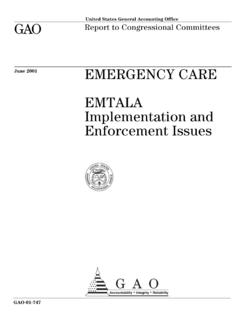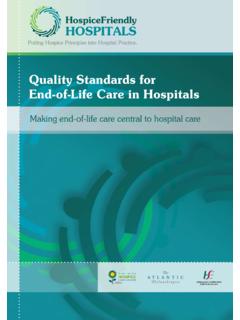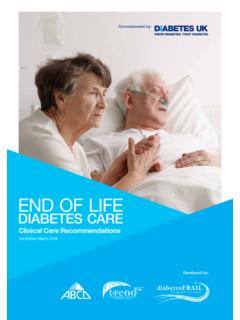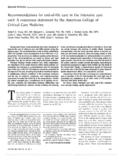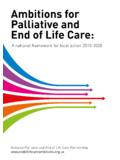Transcription of INTERPRETIVE GUIDELINES - RESPONSIBILITIES OF …
1 INTERPRETIVE GUIDELINES - RESPONSIBILITIES OF MEDICARE PARTICIPATING HOSPITALS IN EMERGENCY CASESTAGNUMBERREGULATIONGUIDANCE TO SURVEYORSA400 Basic Section 1866commitments relevant to Section provider agrees--(l) In the case of a hospital as defined in (b), to comply with GUIDELINES : (l) (l) requires the provider to comply with However 1866(a)(1)(I)(i) of theAct requires providers to adopt and enforce a policy to ensure compliance with therequirements of 1867 ( ). Non-compliance is a violation of the provider's agreementwith the Health Care Financing Administration (HCFA). Therefore, if the provider violates , cite a corresponding violation of (l); but if the provider does not adopt andenforce procedures and policies to ensure compliance with , cite a violation of 1866(a)(1)(I)(i). oCheck the bylaws/rules and regulations of the medical staff to determine if they reflectthe requirements of and the related requirements at the emergency department policies and procedure manuals for proceduresrelated to the requirements of and the related requirements at term " hospital " is defined in (b) as including a rural primary care hospital asdefined in 1861(mm)(1) of the (m) In the case of a hospital as defined in (b), to report to HCFA or the Statesurvey agency any time it has reason tobelieve it may have received anindividual who has been transferred in anunstable emergency medical conditionfrom another hospital in violation of therequirements of (d).
2 INTERPRETIVE GUIDELINES : (m)Look for evidence that the receiving (recipient) hospital knew or suspected the individual hadbeen to a hospital prior to the receiving (recipient) hospital and had not been transferred inaccordance with (d). (Evidence may be obtained in the medical record or throughinterviews with the patient, family members or staff.) However, termination of the receiving(recipient) hospital should be suspended pending confirmation of the suspected the emergency department log and medical records of patients received astransfers. Look for evidence that:oThe hospital had agreed in advance to accept the transfers;oThe hospital had received appropriate medical records;oAll transfers had been effected through qualified personnel, transportation equipmentand medically appropriate life support measures; andoThe hospital had available space and qualified personnel to treat the 205-98V-13 INTERPRETIVE GUIDELINES - RESPONSIBILITIES OF MEDICARE PARTICIPATING HOSPITALS IN EMERGENCY CASESTAGNUMBERREGULATIONGUIDANCE TO SURVEYORSA402(q) In the case of a hospital as defined in (b)--(1) To post conspicuously in anyemergency department or in a place orplaces likely to be noticed by allindividuals entering the emergencydepartment, as well as those individualswaiting for examination and treatment inareas other than traditional emergencydepartments (that is, entrance, admittingarea, waiting room, treatment area) a sign(in a form specified by the Secretary)specifying the rights of individuals undersection 1867 of the Act with respect toexamination and treatment for emergencymedical conditions and women in labor.
3 And (2) To post conspicuously (in a formspecified by the Secretary) informationindicating whether or not the hospital orrural primary care hospital participates inthe Medicaid program under a State planapproved under Title XIX; INTERPRETIVE GUIDELINES : (q)At a minimum:oThe sign(s) must specify the rights of individuals with emergency conditions andwomen in labor who come to the emergency department for health care services;oIt must indicate whether the facility participates in the Medicaid program;oThe wording of the sign(s) must be clear and in simple terms and language that areunderstandable by the population served by the hospital ; andoThe sign(s) must be posted in a place or places likely to be noticed by all individualsentering the emergency department, as well as those individuals waiting for examination andtreatment ( , entrance, admitting area, waiting room, treatment area).A403(r) In the case of a hospital as defined in (b) (including both the transferringand receiving hospitals), to maintain--(1) Medical and other records related toindividuals transferred to or from thehospital for a period of 5 years from thedate of the transfer; INTERPRETIVE GUIDELINES : (r)(1)The medical records of individuals transferred to or from the hospital must be retained intheir original or legally-reproduced form in hard copy, microfilm, microfiche, optical disks,computer disks, or computer memory.
4 Rev. 205-98V-14 INTERPRETIVE GUIDELINES - RESPONSIBILITIES OF MEDICARE PARTICIPATING HOSPITALS IN EMERGENCY CASESTAGNUMBERREGULATIONGUIDANCE TO SURVEYORSA404(2) A list of physicians who are on call for dutyafter the initial examination to provide furtherevaluation and/or treatment necessary tostabilize an individual with an emergencymedical condition; andINTERPRETIVE GUIDELINES : (r)(2)The purpose of the on-call list is to ensure that the emergency department is prospectively aware ofwhich physicians, including specialists and subspecialists, are available to provide treatmentnecessary to stabilize individuals with emergency medical conditions. If a hospital offers a service tothe public, the service should be available through on-call coverage of the emergency medical staff by-laws or policies and procedures must define the responsibility of on-callphysicians to respond, examine and treat patients with emergency medical , including specialists and subspecialists ( , neurologists) are not required to be on callat all times.
5 The hospital must have policies and procedures to be followed when a particularspecialty is not available or the on-call physician cannot respond because of situations beyond his orher hospital has the discretion to maintain the on-call list in a manner to best meet the needs of are not required to be on call in their specialty or subspecialty for emergencies wheneverthey are visiting their own patients in a the hospital 's policy with respect to response time of the on-call physician. Hospitals areresponsible for ensuring that on-call physicians respond within a reasonable period of time. Note thetime of notification and the response (or transfer) a staff physician is on-call to provide emergency services or to consult with an emergency roomphysician is in the area of his or her expertise, that physician would be considered to be available atthe a physician is on-call in an office it is not acceptable to refer emergency cases to their officesfor examination and treatment.
6 The physician must come to the hospital to examine the patientunless the physician is a hospital -owned facility on contiguous land or on the hospital a physician demonstrates a pattern of not arriving at the hospital while on-call, but directs thepatient to be transferred to another hospital where that physician can treat the patient, this may be (3) A central log on each individual who comes to the emergency department, asdefined in (b), seeking assistance andwhether he or she refused treatment, wasrefused treatment, or whether he or she wastransferred, admitted and treated, stabilizedand transferred, or GUIDELINES : (r)(3)The purpose of the central log is to track the care provided to each individual who comes to thehospital seeking care for an emergency medical condition. Each hospital has the discretion to maintain the central log in a form that best meets the needs of itspatients. The central log includes, directly or by reference, patient logs from other areas of thehospital, such as pediatrics and labor and delivery where a patient might present for emergencyservices or receive a medical screening examination instead of in the emergency department.
7 Theseadditional logs must be available in a timely manner for surveyor the emergency department log covering at least a six month period that contains informationon all patients coming to the emergency department and check for completeness, gaps in entries ormissing 205-98V-15 INTERPRETIVE GUIDELINES - RESPONSIBILITIES OF MEDICARE PARTICIPATING HOSPITALS IN EMERGENCY CASESTAGNUMBERREGULATIONGUIDANCE TO SURVEYORSA405(Cont.)A406 Special RESPONSIBILITIES ofMedicare hospitals in emergencycases.(a) General. In the case of a hospital thathas an emergency department,Select a sample of records from the past six months from the log for review to determinecompliance with the requirements, according to the sample size methodology inTask 2. Select an older sample if the case to be investigated occurred longer than sixmonths ago, or if you are concerned about a possible long-term pattern of PROVISIONS OF THIS REGULATION APPLY TO ALL HOSPITALS THATPARTICIPATE IN MEDICARE AND PROVIDE EMERGENCY SERVICESH ospitals providing emergency services are required to provide for an appropriate medicalscreening examination; provide necessary stabilizing treatment for emergency medicalconditions and labor; provide for an appropriate transfer of the patient if the hospital doesnot have the capability or capacity to provide the treatment necessary to stabilize theemergency medical condition; , not delay examination and/or treatment in order to inquireabout the patient s insurance or payment status.
8 Accept appropriate transfers of patientswith emergency medical conditions if the hospital has the specialized capabilities notavailable at the transferring hospital and has the capacity to treat those individuals; if thepatient refuses examination, treatment, or transfer to obtain or attempt to obtain written andinformed refusal of examination, treatment or appropriate transfer; and not take adverseaction against a physician or qualified medical personnel who refuses to transfer a patientwith an emergency medical condition, or against an employee who reports a violation ofthese GUIDELINES : (a)A " hospital with an emergency department" is defined in paragraph (b) of this section as onewhich offers services for emergency medical conditions within its capability to do so. Lack ofan established emergency department is not an indication that emergency services are notprovided. If a hospital offers emergency services for medical, psychiatric or substanceabuse emergency conditions, it is required, within its capability and capacity, to comply withall the anti-dumping statutory a psychiatric hospital offers services for medical, psychiatric, or substance abuseemergency conditions, it is obligated to comply with all of the anti-dumping requirements of and psychiatric hospitals are accredited by the Joint Commission and have an emergencydepartment which provides reasonable care in determining whether an emergency exists,renders life saving first aid, and makes appropriate referrals to the nearest organizations thatare capable of providing needed services.
9 The emergency department must have amechanism for providing physician coverage at all times. Rev. 205-98V-16 INTERPRETIVE GUIDELINES - RESPONSIBILITIES OF MEDICARE PARTICIPATING HOSPITALS IN EMERGENCY CASESTAGNUMBERREGULATIONGUIDANCE TO SURVEYORSA406(Cont.)If any individual (whether or not eligiblefor Medicare benefits and regardless ofability to pay) comes by him or herself orwith another person to the emergencydepartment and a request is made on theindividual s behalf for examination ortreatment of a medical condition byqualified medical personnel (asdetermined by the hospital in its rules andregulations), the hospital must provide foran appropriate MEDICAL SCREENINGEXAMINATION within the capability ofthe hospital s emergency department,including ancillary services routinelyavailable to the emergency departmentEmergency services need not be provided in a location specifically identified as anemergency room or an emergency department.
10 If an individual arrives at a hospital and isnot technically in the emergency department, but is on the premises (including the parkinglot, sidewalk and driveway) of the hospital and requests emergency care, he or she isentitled to a medical screening examination. For example, it may be the hospital s policy todirect all pregnant women to the labor and delivery area of the hospital . Hospitals may useareas to deliver emergency services which are also used for other inpatient or outpatientservices. Medical screening examinations or stabilization may require ancillary servicesavailable only in areas or facilities of the hospital outside of the emergency department. Aslong as the patient is directed to a hospital -owned facility which is contiguous ( , any areawithin the hospital or a hospital -owned facility on land that touches land where a hospital semergency department sits) or is part of the hospital campus and is owned by the hospital ,and is operating under the hospital 's provider number, the hospital is complying with 1867.
